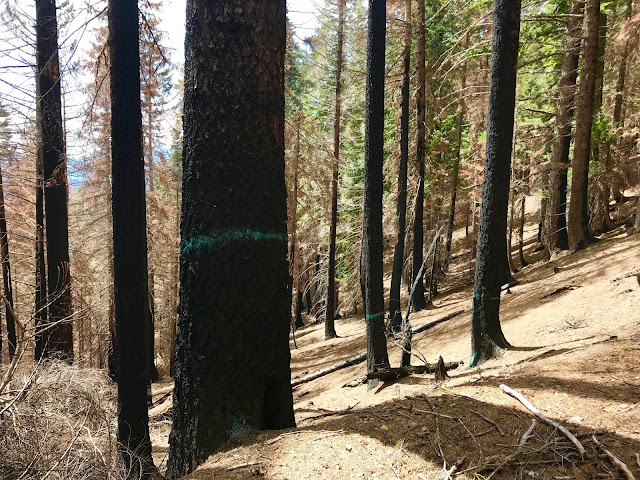 |
| Old-growth forest proposed for logging in the Upper Briggs Restoration Project on the Secret Way Trail, south of Sam Brown Campground. |
Upper Briggs Restoration Project: Old forest logging proposed on Briggs Creek! Please comment now, the comment period ends May 31st!
Briggs Creek is a beautiful stream flowing south into the Illinois River canyon from its headwaters near Onion Mountain Lookout, Taylor Mountain, and to the west, Chrome Ridge. The region contains steep forested slopes, gentle green meadows at Briggs Valley, serpentine ridges, and clear flowing streams. Briggs Creek is an important cold water tributary of the Illinois River with runs of coho salmon and steelhead trout. It is also an important recreation area just west of Grants Pass, Oregon with the world's tallest ponderosa pine trees.
The region has a rich human history of indigenous land management, and later, of mining, logging, ranching and recreation. The creek is named for George Briggs who packed supplies into the area for local miners with a team of mules. Starting in the late 1860s, the creek was heavily mined for gold. Most of the mining was taking place in the streams and fishery habitats on Briggs Creek and smaller tributaries.
By the 1920s new roads led out to chromium mines on aptly named Chrome Ridge, and placer mining continued in the streams. Around this time settlers farmed and ranched the small meadows near Sam Brown Campground and Horse Creek Meadows. Later logging roads were built throughout the watershed and both clearcut and selective logging was common from the 1940s to the 1990s. Today, over 170 miles of road have been built within the Briggs Creek Watershed and roughly 7,000 acres have been clearcut by the Rogue River Siskiyou National Forest.
 |
| Old-growth forest proposed for logging to 40% canopy cover in unit 23 along the Secret Way Trail. |
Since at least the 1960s the Forest Service has also managed numerous recreation sites in the Briggs Creek area, and generations of southern Oregon residents have fallen in love with the region for camping, hiking, and more recently, mountain biking.
Unfortunately, the Forest Service has proposed the Upper Briggs Creek Restoration Project, a large landscape-scale timber sale that would log over 4,000 acres around the Sam Brown Campground, along recreational trails, in the Horse Creek Meadows Wildlife Area and in Critical Habitat for the Northern spotted owl.
Klamath Forest Alliance has been monitoring proposed timber sale units and has prepared a detailed public comment advocating for old-growth forests, Northern spotted owl habitat and the protection of beautiful meadows in the Horse Creek Meadows Wildlife Area.
We are especially concerned by the proposal to log old forest habitats and to conduct so-called "meadow restoration" treatments.
 |
| Horse Creek Meadow Wildlife Area will be subjected to heavy industrial logging both in the meadow itself and in the forest surrounding the meadow. |
The supposed meadow restoration treatments proposed in the Upper Briggs Restoration Project would clearcut large swaths of forest adjacent to existing meadow habitats in the Horse Creek Meadows Wildlife Area and around Sam Brown Campground. The proposal also advocates logging all trees within the meadows that are less than 120 years old.
Klamath Forest Alliance supports non-commercial meadow restoration measures that may include non-commercial thinning, prescribed fire, invasive plant removal, and native pollinator plant restoration.
 |
| Beautiful old forest proposed for logging on the Secret Way Trail in unit 23B. |
What do you prefer? Camping and hiking among old-growth forests and beautiful mountain meadows, or stumpfields disguised as "restoration?"
Please consider commenting on the Upper Briggs Restoration Project Environmental Assessment. The comment period ends on May 31, 2018.
Send your comments to:
comments-pacificnorthwest-siskiyou-wildrivers@fs.fed.us
&
mpaciorek@fs.fed.us
Upper Briggs Restoration Project Talking Points:
- Cancel all proposed logging units in old-growth or late successional forest habitats including units 2, 9, 20, 21, 22, 23, 23b, 23c, 55 & 70.
- Cancel logging units with large populations of the rare clustered lady's slipper orchid, including units 21 and 22.
- Do not implement meadow restoration that logs trees within or surrounding mountain meadows or campgrounds. Institute non-commercial meadow restoration treatments instead.
- Do not approve the Red Tree Vole Habitat Conservation Plan and maintain all current protections for the red tree vole, including site protection measures and pre-disturbance surveys.
- Do not downgrade Northern spotted owl habitat.
- Logging the Horse Creek Meadow Wildlife Area and Sam Brown Meadow in Meadow Restoration Treatments is inconsistent with the mandates of the Siskiyou National Forest Plan.
- Cancel all new road construction proposed in the Upper Briggs Restoration Project.
- Do not implement Oak-Pine Restoration Treatments in Douglas fir plant associations. The proposal will create novel forest conditions and is not restorative in nature.
















